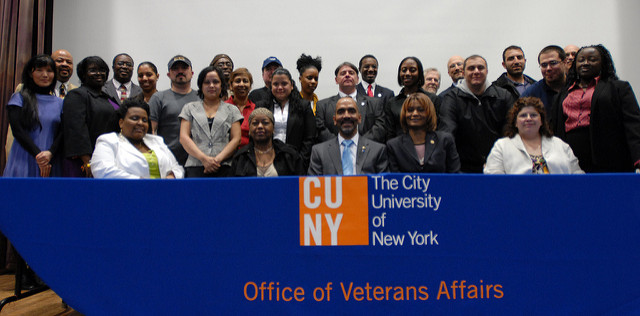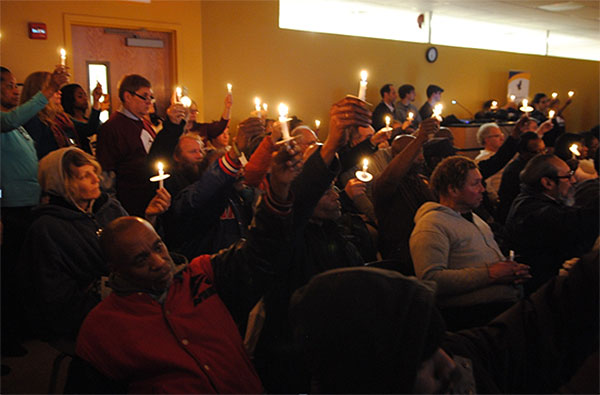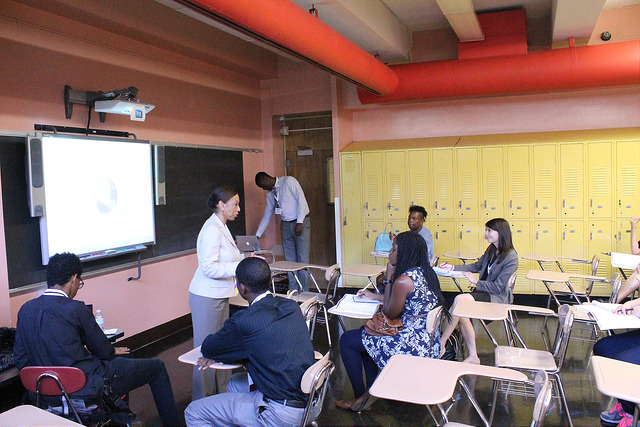CUNY's Insufficient Response to Military Veteran-Students

photo via CUNY
The December 8 response from CUNY’s Interim Vice Chancellor Christopher Rosa to Joe Bello's Gotham Gazette op-ed of the day prior surprised many student-veterans on CUNY campuses -- including the ten signatories of this letter.
To begin with, we were not aware that CUNY actually recruits veterans to its campuses, as IVC Rosa asserted. From our experience, military veterans usually attend a CUNY school based on a campus location or a school’s specialization - degree programs, specialty programs like Veterans Upward Bound - and, most importantly, word of mouth from other veterans. None of us have seen any recruitment directed at veterans, either through advertising or social media, at our prior military commands or when we came to New York City.
Also, while CUNY does waive our application fees, it is not clear to us who are the “deployed, dedicated admissions counselors” who supposedly smooth our way through admission. For many, admission into the CUNY system is a long and arduous process and at no time did we meet counselors “deployed” to help us. If anything, many of us were referred to CUNY’s admissions website for veterans.
With regard to IVC Rosa stating that CUNY works to "assure that New Yorkers eligible for the Post 9/11 GI Bill attend 100 percent cost-free," the U.S. Department of Veterans Affairs pays our tuition to the campuses based on our length and type of military service. This means that not every student-veteran, or eligible dependent, utilizing tuition assistance from the Department of Veteran Affairs is attending without a financial burden.
Furthermore, we question IVC Rosa’s statement that the “veterans services coordinators are a one-stop resource to support veterans in their transition from military life to higher education.” As Mr. Bello stated in his op-ed, Baruch College does not have a coordinator and other CUNY campuses currently have issues of harassment, alienation, and unresolved complaints lodged with their respective coordinators. These issues, as well as others on CUNY campuses, have led many student-veterans to help themselves to find the resources to support them in their transition.
Lastly, on IVC Rosa’s statement that CUNY was the first university system in America to be named “military friendly” by Victory Media: as several people testified at the November 15 City Council hearing, any college can obtain this designation by filling out a form that Victory Media provides. Case in point, over three semesters LaGuardia Community College has been engaged in a dispute with its student-veterans regarding their current coordinator, yet the school still received the “veteran friendly” designation, and even as that college’s student-veteran enrollment numbers have decreased. There seems to be no real mechanism in place by either Victory Media or CUNY to really know which institutions deserve the designation and which don't.
IVC Rosa states that “external rankings validate the welcoming environment at CUNY colleges for those who have served their country.” However, as individuals who have served this country and are currently pursuing degrees within the CUNY system, we have to ask: When will the ongoing battles of CUNY’s student-veteran population begin to be addressed by the leadership at CUNY?
IVC Rosa's letter appeared to be nothing more than an attempt to put a stop to the discussions that are currently going on between CUNY and its student-veterans, and his letter does not address the issues raised by Mr. Bello in his op-ed.
We want IVC Rosa and CUNY leadership to understand that while they state that CUNY cares about its student-veterans, many campuses do not have the necessary resources to allow our successful transition from military to higher education. Therefore, we are demanding that the Board of Trustees and CUNY leadership take action to make CUNY live up to its “military friendly” designation. If not, then all that we -- as skilled, hard-working and experienced student-veterans -- bring to our CUNY campuses, including our federal dollars, can be taken elsewhere.
Trent Coyle
US Army, Baruch College
Sungin Hong
USMC, Baruch College
Melissa Siew
USMC, Baruch College
Christian Espada
US Army, Bronx Community College
Margie Guzman
US Army, Bronx Community College
Noah Almonor
US Army, City College
Ishmael Shalom
USMC, John Jay College
Bryan Williams
USCG, John Jay College
Kevin Chimilio
USMC, Lehman College
Ricky Malone
USCG, Queens College
***
Have an op-ed idea or submission for Gotham Gazette? Email This email address is being protected from spambots. You need JavaScript enabled to view it.
Observing Homeless Persons’ Memorial Day & Committing To End It

2015 Homeless Persons’ Memorial (photo: Care for the Homeless)
Today, Wednesday December 21, advocacy and social justice organizations in cities across the country gather together to observe Homeless Persons’ Memorial Day. This annual remembrance is held on winter solstice. It’s fitting this solemn occasion is scheduled for the longest, darkest night of the year, because each night without housing is long, dark and cold.
In New York City, where the number of people experiencing homelessness is at its all-time high, there will be several observances. The NYC Providers of Health Care for the Homeless held one last week. Picture the Homeless will hold a program at Judson Memorial Church today, Wednesday, at 6 p.m.
Today at 5 p.m., our organizations -- Care for the Homeless and Urban Pathways -- will hold an observance at Drisha Institute for Jewish Education, on West 65 Street. The program, which is free and open to the public, will feature currently and formerly homeless clients reading the names of and eulogizing those who experienced homelessness who died in New York City this year. As each name is read a bell will toll, a candle will be lit, and information about the deceased will be projected on a screen.
Many that we remember during homeless persons’ memorial programs would not be memorialized without such gatherings. But we know and remember that each individual, regardless of their housing situation, has value and dignity. People are more than the labels we assign them, including that of homeless. Homeless Persons’ Memorial Day provides an opportunity to recommit to the value of all people, including those who have experienced or are experiencing homelessness, and to our fight to end homelessness.
Many that we memorialize have died prematurely. A crucial component of health and well-being is stable housing. Compared to the general population, people who experience homelessness are at greater risk of chronic and infectious illness, mental health challenges, and substance abuse. They are also more often victims of violence. According to the Center for Disease Control and Prevention, homeless persons’ mortality rate is four to nine times higher than those not homeless.
It doesn’t have to be like this. We can end homelessness by focusing on and implementing wise policies. In addition to remembering those who have died, often needlessly, Homeless Persons’ Memorial Day serves to remind us that we have cost-effective solutions to homelessness. The key is supportive housing, which we need to develop now and allow nonprofit organizations to operate to the best of their abilities. We also should employ those experiencing homelessness in outreach programs, shelters, and supportive housing residences. Their lived experiences are valuable, and the opportunity for employment is invaluable.
The time is now to answer the prayer of each Homeless Persons’ Memorial Day program in the 170 cities across North America. One winter solstice, there will be no need to observe Homeless Persons’ Memorial Day.
***
Jeff Foreman is Policy Director at Care for the Homeless. Nicole Bramstedt is Policy Director at Urban Pathways. Both organizations serve homeless adults in New York City. On Twitter: @UrbanPathwaysNY & @CFHNYC.
***
Have an op-ed idea or submission for Gotham Gazette? Email This email address is being protected from spambots. You need JavaScript enabled to view it.
The Specialized High School Exam: A Flawed Test in a Flawed System

(photo: Kevin Caraballo for the DOE)
Every October, roughly one-third of the eligible eighth-graders in New York City -- between 25,000 and 30,000 students -- take the Standardized High School Admissions Test (SHSAT) for a chance to attend one of the city’s eight specialized high schools. Admission to these schools is highly competitive, and spots are coveted. While less than 20% of students who take the test receive an offer, 72% of those who are accepted choose to attend. Yet, despite being in New York City, where the overall student body is 72% black and Hispanic, students of color make up only 12% of specialized high school students, a number that is declining.
This is due to a flawed and exclusionary education system that negatively affects low-income students and students of color from their first day in the system. In New York City, the clear majority of students are assigned elementary schools that are within their zip codes. For many students of color, this means that they attend schools that face a myriad of problems, including: less funding and resources, less experienced and effective teachers and overcrowded classrooms. This, in addition to the various socio-economic problems that students from these backgrounds already face in their daily lives. Ultimately this results in students from these backgrounds having lower attendance rate, lower grades in key subject areas and lower standardized scores.
Next, because entry to middle school is based on those aforementioned metrics, low-income students and students of color are substantially less likely to attend honors or screened programs. Instead, these students attend schools within their zip codes, which face the same issues that elementary schools face. And, analysis shows that between 2005 and 2013, 88 middle schools, 76 of which were honors or screened, were home to 85% of total student offers to SHSAT schools. Demographic data further revealed that students from these schools came from wealthier, and largely white or Asian households.
In addition to the socio-economic advantages that students who enroll into these strong middle schools typically have, they also benefit from attending the schools themselves. Not only are these schools better funded, they also offer more comprehensive and rigorous curricula. Importantly, these schools also dedicate resources to informing students and parents about the SHSAT, and the high-school admissions process in general.
A natural consequence of attending one of these schools is that students and parents are both more likely to have heard of the SHSAT and students are more likely to be prepared to take the exam. It is here that the inequities in the system become reinforced, adversely impacting students in two key ways: first in deciding to take the SHSAT and subsequently, in earning the requisite admission score.
Yet, it would be a mistake to assume that the SHSAT itself is color- or income-blind. Analysis reveals a flawed exam. Like all standardized tests, critics argue that the SHSAT does not test for ability and potential.
Rather, the test is basically an indicator of income and narrow readiness more than anything. Parents who can afford to invest in expensive preparatory courses and high quality private tutors to give their children an advantage -- often added upon prior advantages. Test-prep companies and private tutors are keenly aware of how the test works and impart significant help. Two notable examples of this include:
1. The SHSAT’s decision to favor higher overall scores, rather than balanced ones. This means that a student with a score of 500 (with a score breakdown of 250/250) is viewed less positively than a student who scores a 501 (with a score breakdown of 399/102) – where the lowest score a student can get on a section is a 100, and the highest a 400.
2. In addition, students who prep generally take several simulated SHSATs under test conditions. Since the SHSAT is administered only once per year, students who receive this preparation are much more prepared, psychologically and otherwise, than those who are taking the exam without having practiced a simulation.
Criticisms of the SHSAT are not solely socio-economic. Two reports that examined the SHSAT found that “Students who receive certain versions of the test may be more likely to gain admission than students who receive other versions” and that “the SHSAT ignores widely accepted psychometric standards and practices.” Psychometric standards are evaluations that test for reliability and validity.
In addition, because the cut-off scores for admissions differ slightly from year to year, being accepted on the margins is largely a matter of luck. And finally, the SHSAT only tests for ability in math and reading, other key subjects, such as science and social studies, are not included.
Ultimately, the SHSAT, and the educational system that it sits within, is deeply flawed. Policy changes must be considered to make the system more equitable.
***
Bernard Agrest is a recent graduate of the University of Edinburgh's MPP with a focus on education policy analysis.
***
Have an op-ed idea or submission for Gotham Gazette? Email This email address is being protected from spambots. You need JavaScript enabled to view it.




